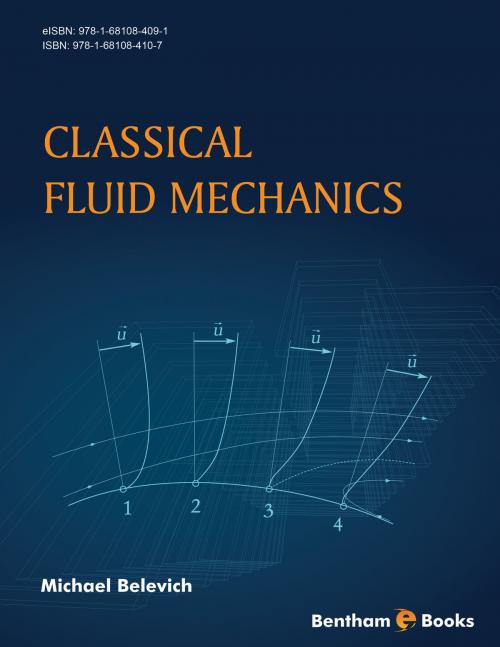| Author: | Michael Belevich | ISBN: | 9781681084091 |
| Publisher: | Bentham Science Publishers | Publication: | September 18, 2017 |
| Imprint: | Language: | English |
| Author: | Michael Belevich |
| ISBN: | 9781681084091 |
| Publisher: | Bentham Science Publishers |
| Publication: | September 18, 2017 |
| Imprint: | |
| Language: | English |
This textbook primarily explains the construction of classical fluid model to readers in a holistic manner and the way it is constructed. Secondly, the book also demonstrates some possible modifications of the initial model which either make the model applicable in some special cases (viscous or turbulent fluids) or simplify it in accordance with peculiarity of a particular problem (hydrostatics, two-dimensional flows, boundary layers, etc.). The book explains theoretical concepts in two parts. The first part is dedicated to the derivation of the classical model of the perfect fluid. The second part of the book covers important modifications to the fluid model which account for calculations of momentum, force and the laws of energy conservation. Concepts in this section include the redefinition of the stress tensor in cases of viscous or turbulent flows and laminar and turbulent boundary layers. The text is supplemented by appropriate exercises and problems which may be used in practical classes. These additions serve to teach students how to work with complex systems governed by differential equations. Classical Fluid Mechanics is an ideal textbook for students undertaking semester courses on fluid physics and mechanics in undergraduate degree programs. This textbook primarily explains the construction of classical fluid model to readers in a holistic manner and the way it is constructed. Secondly, the book also demonstrates some possible modifications of the initial model which either make the model applicable in some special cases (viscous or turbulent fluids) or simplify it in accordance with peculiarity of a particular problem (hydrostatics, two-dimensional flows, boundary layers, etc.). The book explains theoretical concepts in two parts. The first part is dedicated to the derivation of the classical model of the perfect fluid. The second part of the book covers important modifications to the fluid model which account for calculations of momentum, force and the laws of energy conservation. Concepts in this section include the redefinition of the stress tensor in cases of viscous or turbulent flows and laminar and turbulent boundary layers. The text is supplemented by appropriate exercises and problems which may be used in practical classes. These additions serve to teach students how to work with complex systems governed by differential equations. Classical Fluid Mechanics is an ideal textbook for students undertaking semester courses on fluid physics and mechanics in undergraduate degree programs.
This textbook primarily explains the construction of classical fluid model to readers in a holistic manner and the way it is constructed. Secondly, the book also demonstrates some possible modifications of the initial model which either make the model applicable in some special cases (viscous or turbulent fluids) or simplify it in accordance with peculiarity of a particular problem (hydrostatics, two-dimensional flows, boundary layers, etc.). The book explains theoretical concepts in two parts. The first part is dedicated to the derivation of the classical model of the perfect fluid. The second part of the book covers important modifications to the fluid model which account for calculations of momentum, force and the laws of energy conservation. Concepts in this section include the redefinition of the stress tensor in cases of viscous or turbulent flows and laminar and turbulent boundary layers. The text is supplemented by appropriate exercises and problems which may be used in practical classes. These additions serve to teach students how to work with complex systems governed by differential equations. Classical Fluid Mechanics is an ideal textbook for students undertaking semester courses on fluid physics and mechanics in undergraduate degree programs. This textbook primarily explains the construction of classical fluid model to readers in a holistic manner and the way it is constructed. Secondly, the book also demonstrates some possible modifications of the initial model which either make the model applicable in some special cases (viscous or turbulent fluids) or simplify it in accordance with peculiarity of a particular problem (hydrostatics, two-dimensional flows, boundary layers, etc.). The book explains theoretical concepts in two parts. The first part is dedicated to the derivation of the classical model of the perfect fluid. The second part of the book covers important modifications to the fluid model which account for calculations of momentum, force and the laws of energy conservation. Concepts in this section include the redefinition of the stress tensor in cases of viscous or turbulent flows and laminar and turbulent boundary layers. The text is supplemented by appropriate exercises and problems which may be used in practical classes. These additions serve to teach students how to work with complex systems governed by differential equations. Classical Fluid Mechanics is an ideal textbook for students undertaking semester courses on fluid physics and mechanics in undergraduate degree programs.















